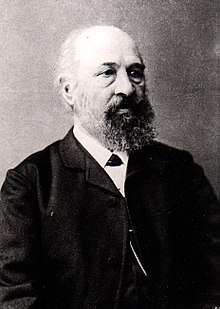Hermann Hellriegel
Hermann Hellriegel (October 21, 1831 – September 24, 1895)[1] was a German agricultural chemist who discovered that leguminous plants assimilate the free nitrogen of the atmosphere.
Hermann Hellriegel | |
|---|---|
 | |
| Born | October 21, 1831 Mausitz, Saxony |
| Died | September 24, 1895 (aged 63) Bernburg, Anhalt |
Biography
He was born at Mausitz (near Pegau), in Saxony. In 1857 he became director of the agricultural experiment station of Brandenburg and Niederlausitz at Dahme, from which he resigned in 1873, and in 1882 accepted a similar post at Bernburg, where he died. From 1873 to 1882, he was Wanderlehrer (circuit riding teacher) at Bernburg.
Nitrogen fixation
Among his many agricultural investigations with plants, the most important by far are his demonstration of the ability of leguminous plants to assimilate the free nitrogen of the air, and his discovery of the tubercles on the roots as the agency through which this takes place. The question of the ability of leguminous plants to use the nitrogen of the air had long been one of inquiry, and its settlement by him marked an epoch in the agricultural world. The important parts of these experiments he published in Untersuchungen über die Stickstoffnahrung der Gramineen und Leguminosen (Investigations into the Nitrogen assimilation of the Gramineae and Leguminosae; Berlin, 1888), and Ueber Stickstoffnahrung landwirtschaftlicher Kulturgewächse (On Nitrogen assimilation in agricultural crops; Vienna, 1890).
Notes
- "Hermann Hellriegel". Nature. 53 (1358): 11. 1895. Bibcode:1895Natur..53Q..11.. doi:10.1038/053011a0.
References
- This article incorporates text from a publication now in the public domain: Gilman, D. C.; Peck, H. T.; Colby, F. M., eds. (1905). . New International Encyclopedia (1st ed.). New York: Dodd, Mead. This work in turn cites:
- Römer, Hermann Hellriegel, Nachruf (Leipzig, 1896)
External links
| Wikisource has original works written by or about: Hermann Hellriegel |